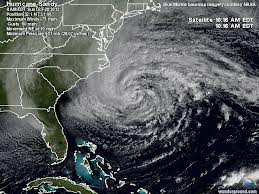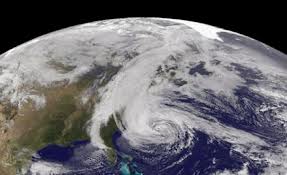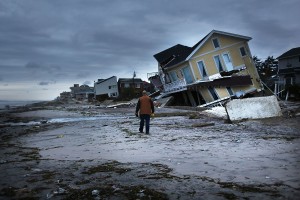It’s not over as Sandy slowly dissipates its energy over the northeastern parts of the United States and Atlantic Canada, but this hurricane has got a whole bunch of global warming deniers suddenly jumping on the bandwagon of climate change. Glad you are aboard but Hurricane Sandy is weather, not climate change. And as weather it may be an example of the impact of global warming. Only time will tell.
The Anthropocene is the geologic age we live in today. Anthropocene is defined as the period of Earth’s history that is dominated by humanity’s footprint on the planet. That “footprint” begins in the Industrial Revolution of the 18th century and continues to the present day. It has been accompanied by rising human population, massive deforestation, increases in greenhouse gases in the atmosphere, pollution of land and water, changes to the pH levels in the ocean, and rising ocean and atmospheric temperatures. A consequence of rising temperatures appears to be weather of an unusual nature occurring with increasing frequency.
And to say Hurricane Sandy was anything but unusual would be a lie. Sandy became massive, not formed where “hurricanes hardly ever happen” but in the warm waters of the equatorial Atlantic Ocean. From there the storm gathered strength fed by unusually warm surface waters. After it struck Haiti and Cuba it moved north continuing to gather strength while it passed over the Gulf Stream and the Bahamas. Continuing northeast it slowly made its way up the Atlantic coastline of the United States until it made a sharp turn and landfall over the Delmarva Peninsula and the Jersey Shore. Sandy got large because it wandered over warm water that pumped energy into its swirling mass. And it continued to grow because of the sudden dip in the Jet Stream pushed south by an injection of cold air from the North. The juxtaposition of cold and warm air added even more energy to the storm.
We all know now the end result. Combined with a full moon, high tides, enduring winds and heavy rainfall, Sandy wreaked havoc on the most densely populated part of the United States. New York City, Long Island and the New Jersey coastline will need a considerable amount of time to recover.
Did human activity cause Sandy? No! But we may have influenced the change in the atmosphere that could lead to a weather event like this storm? Climatologists have been studying how rising air and ocean temperatures can lead to more intense storms and other extremes of weather. Researchers are actually starting to understand the variables of climate change by incorporating the pumping of warmer air into their climate models. And the research is indicating that storms like Sandy may no longer be a one in a century event.
Researchers have also been studying the melting sea ice of the Arctic Ocean and Sandy and melting sea ice are correlated. The dip in the Jet Stream that occurred just before Sandy’s arrival off the Jersey Shore is a phenomenon known as the North Atlantic Oscillation. Its arrival is linked to melting sea ice. And lately it has been arriving earlier creating more extreme weather as cold Arctic high pressure clashes with warm Atlantic low pressure cells. Charles Greene and Bruce Monger of Cornell University recently published a paper in Oceanography in which they stated that sea ice melting is creating a new Arctic wild card that will lead to weather surprises with consequences that can be modeled and predicted.
What’s in the future for New York City and the Jersey Shore? If Greene and Monger are right then the United States may have to embark on building an Atlantic seawall to protect the population that resides along its shore or otherwise face future storms as devastating in impact as Hurricane Sandy.



















[…] This made me think about other recent personifications of weather, as being ‘on steroids’ for example, and I asked myself: is (extreme) weather becoming personified in new ways? And does some weather even begin to personify climate change? (as Len Rosen asked in 2012: Is Hurricane Sandy Climate Change Personified?) […]